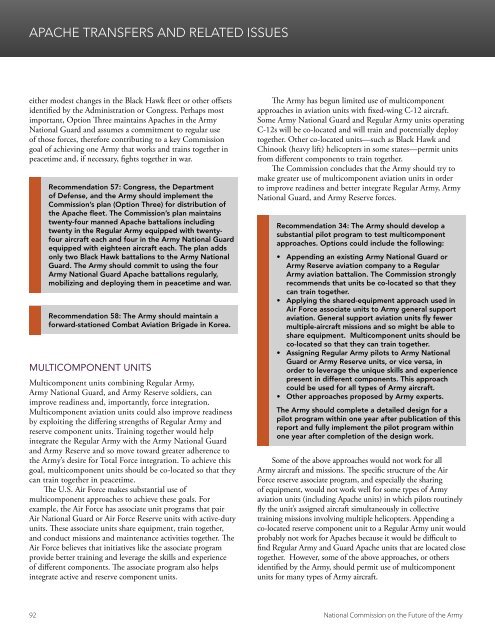THE FUTURE OF THE ARMY
Futurearmy
Futurearmy
You also want an ePaper? Increase the reach of your titles
YUMPU automatically turns print PDFs into web optimized ePapers that Google loves.
APACHE TRANSFERS AND RELATED ISSUES<br />
either modest changes in the Black Hawk fleet or other offsets<br />
identified by the Administration or Congress. Perhaps most<br />
important, Option Three maintains Apaches in the Army<br />
National Guard and assumes a commitment to regular use<br />
of those forces, therefore contributing to a key Commission<br />
goal of achieving one Army that works and trains together in<br />
peacetime and, if necessary, fights together in war.<br />
Recommendation 57: Congress, the Department<br />
of Defense, and the Army should implement the<br />
Commission’s plan (Option Three) for distribution of<br />
the Apache fleet. The Commission’s plan maintains<br />
twenty-four manned Apache battalions including<br />
twenty in the Regular Army equipped with twentyfour<br />
aircraft each and four in the Army National Guard<br />
equipped with eighteen aircraft each. The plan adds<br />
only two Black Hawk battalions to the Army National<br />
Guard. The Army should commit to using the four<br />
Army National Guard Apache battalions regularly,<br />
mobilizing and deploying them in peacetime and war.<br />
Recommendation 58: The Army should maintain a<br />
forward-stationed Combat Aviation Brigade in Korea.<br />
MULTICOMPONENT UNITS<br />
Multicomponent units combining Regular Army,<br />
Army National Guard, and Army Reserve soldiers, can<br />
improve readiness and, importantly, force integration.<br />
Multicomponent aviation units could also improve readiness<br />
by exploiting the differing strengths of Regular Army and<br />
reserve component units. Training together would help<br />
integrate the Regular Army with the Army National Guard<br />
and Army Reserve and so move toward greater adherence to<br />
the Army’s desire for Total Force integration. To achieve this<br />
goal, multicomponent units should be co-located so that they<br />
can train together in peacetime.<br />
The U.S. Air Force makes substantial use of<br />
multicomponent approaches to achieve these goals. For<br />
example, the Air Force has associate unit programs that pair<br />
Air National Guard or Air Force Reserve units with active-duty<br />
units. These associate units share equipment, train together,<br />
and conduct missions and maintenance activities together. The<br />
Air Force believes that initiatives like the associate program<br />
provide better training and leverage the skills and experience<br />
of different components. The associate program also helps<br />
integrate active and reserve component units.<br />
The Army has begun limited use of multicomponent<br />
approaches in aviation units with fixed-wing C-12 aircraft.<br />
Some Army National Guard and Regular Army units operating<br />
C-12s will be co-located and will train and potentially deploy<br />
together. Other co-located units—such as Black Hawk and<br />
Chinook (heavy lift) helicopters in some states—permit units<br />
from different components to train together.<br />
The Commission concludes that the Army should try to<br />
make greater use of multicomponent aviation units in order<br />
to improve readiness and better integrate Regular Army, Army<br />
National Guard, and Army Reserve forces.<br />
Recommendation 34: The Army should develop a<br />
substantial pilot program to test multicomponent<br />
approaches. Options could include the following:<br />
• Appending an existing Army National Guard or<br />
Army Reserve aviation company to a Regular<br />
Army aviation battalion. The Commission strongly<br />
recommends that units be co-located so that they<br />
can train together.<br />
• Applying the shared-equipment approach used in<br />
Air Force associate units to Army general support<br />
aviation. General support aviation units fly fewer<br />
multiple-aircraft missions and so might be able to<br />
share equipment. Multicomponent units should be<br />
co-located so that they can train together.<br />
• Assigning Regular Army pilots to Army National<br />
Guard or Army Reserve units, or vice versa, in<br />
order to leverage the unique skills and experience<br />
present in different components. This approach<br />
could be used for all types of Army aircraft.<br />
• Other approaches proposed by Army experts.<br />
The Army should complete a detailed design for a<br />
pilot program within one year after publication of this<br />
report and fully implement the pilot program within<br />
one year after completion of the design work.<br />
Some of the above approaches would not work for all<br />
Army aircraft and missions. The specific structure of the Air<br />
Force reserve associate program, and especially the sharing<br />
of equipment, would not work well for some types of Army<br />
aviation units (including Apache units) in which pilots routinely<br />
fly the unit’s assigned aircraft simultaneously in collective<br />
training missions involving multiple helicopters. Appending a<br />
co-located reserve component unit to a Regular Army unit would<br />
probably not work for Apaches because it would be difficult to<br />
find Regular Army and Guard Apache units that are located close<br />
together. However, some of the above approaches, or others<br />
identified by the Army, should permit use of multicomponent<br />
units for many types of Army aircraft.<br />
92 National Commission on the Future of the Army


